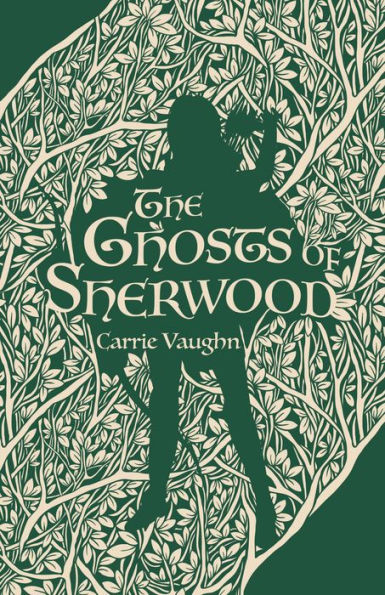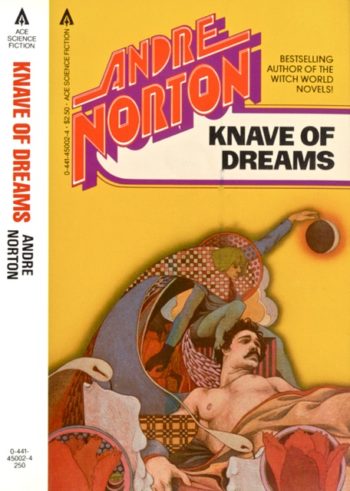Now I understand why the regulars from the Comments section urged me to read Knave of Dreams while I’ve been checking out Norton’s earliest published novels, notably The Prince Commands. Knave of Dreams is a relatively late entry, from 1975. There are forty years of novels and stories between the two, and whole worlds discovered and created. And yet the roots are the same: the Ruritanian Romance that was so much in vogue when Norton was a brand-new writer.
Young Andre played her fanfic straight: setting The Prince Commands in the classic imaginary European country. Mature Andre had been writing fantasy and science fiction for decades, and had a wide array of storytelling tools to choose from. Knave of Dreams is a Ruritanian adventure in the sense of the royal impostor from America swept away to the foreign kingdom and thrown headlong into complicated court intrigue. It’s also an alternate-worlds story and a kind of portal adventure.
And, in its way, it’s a rewrite of her less than successful 1967 time-travel adventure-romance, Operation Time Search.
Here as in that last, a contemporary American with a somewhat similar name—Ramsay rather than Ray—is involuntarily transported to a strange and exotic world. Ray travels backwards in time, whereas Ramsay travels sidewise, but they both end up in empires in flux, and each serves as a catalyst for major changes in the world and its rulers. Among whom, in each novel, is a young, strong female character who plays a crucial role in the plot.
Buy the Book


The Ghosts of Sherwood
There are evil priests and ancient, nearly forgotten civilizations and technologies, pirates and renegades, psychic powers and mind control. And, as so often in Norton novels, characters driven by forces outside of themselves. Destiny and predestination rule; it’s difficult if not impossible for the protagonist to act on his own, though he dedicates a great deal of energy to the effort.
The difference here is that Ramsay is aware of the forces that are acting on him, and he does not go quietly. In fact, he learns that he is a sort of cosmic spoiler, the eponymous Knave of Dreams: a person who can manipulate the fabric of reality, and dream it into the pattern of his own desire. He starts as the victim of his own dreams, pulled out of his native world and into another, but even before he realizes the nature of his powers, he doesn’t quite fall into the role assigned to him. Over the course of the novel he takes control of his own destiny—though it fights back hard.
The result is an interesting mix of headlong adventure and static speechifying. We begin with the old Empress and her Shaman in a somewhat stagey setting, Having A Meeting and Explaining The Setup. Then suddenly we’re in the USA ca. 1975 with young Ramsay fretting over his role in a university dream study. His dreams are weird and vivid and they’re starting to really worry him.
And then, even more suddenly, he’s lying on a slab in his dream world, and that world has become all too real. He’s an imperial heir, a prince named Kaskar, and the political situation is complicated to say the least. Just for starters, Kaskar is dead, and so is Ramsay supposed to be. It’s not in anybody’s plan for him to be alive and inhabiting Kaskar’s body. He knows nothing of the language or the culture or the history. He has to learn them all under the supervision of the beautiful Duchess Thecla.
Once Ramsay makes the transition to the alternate world, the action comes fast and furious. He has numerous doubts and moments of resistance, and he just wants to go home—that’s a staple of Ruritanian Romance—but first he has to play out the destiny of his assumed identity. And then of course, at the end, he has a choice to make. He can’t go home again; there’s no way back. But will he continue to live as Kaskar, or allow Kaskar to die officially as well as actually, and go off on new adventures on the far side of the world?
That’s the choice left to Ray, but Ramsay makes a different one. And gets the girl, too, with typical Norton abruptness, in the very last line.
The novel pays tribute to Seventies feminism—female rulers, and Strong Female Characters with Actual Speaking Roles—but the culture is persistently patriarchal. All the fighters are male, and nearly all of the characters as well as the spear-carriers are male as well. The Empress rules as regent; her heirs are male. The Duchess appears to have inherited as a matter of course, but there aren’t any male challengers for the title. It’s still a man’s world, though women are starting to encroach on it.
It’s also a non-white world. Ramsay is frequently described as dark-skinned and his alter ego Kaskar is darker still, a habit of description that points to Norton’s own, very white though consciously diverse viewpoint. He is, she says, half Iroquois. The alternate world isn’t very close to our own at all—it’s full of basically Forerunner technology, and it is emerging from the aftermath of an ancient atomic holocaust—but from hints that are dropped, it appears to be set in a North America that was never colonized by white Europeans. The people look like Native Americans but dress like Vulcans from Star Trek Classic. There are references to North American animal symbols and actual animals, notably Kaskar’s eagle tattoo and the elk or wapiti that pull Thecla’s wagon.
It’s interesting. It’s not Norton’s best novel or world or characters, but it’s far from her worst. In quite a few ways it makes up for the missteps of Operation Time Search, and it has rather poignant echoes of her youthful fascination with Graustark and Ruritania.
Next time I’ll begin reading another very early series, a trio of World War II adventures beginning with The Sword is Drawn.
Judith Tarr’s first novel, The Isle of Glass, appeared in 1985. Since then she’s written novels and shorter works of historical fiction and historical fantasy and epic fantasy and space opera and contemporary fantasy, many of which have been reborn as ebooks. She has even written a primer for writers: Writing Horses: The Fine Art of Getting It Right. She has won the Crawford Award, and been a finalist for the World Fantasy Award and the Locus Award. She lives in Arizona with an assortment of cats, a blue-eyed dog, and a herd of Lipizzan horses.










